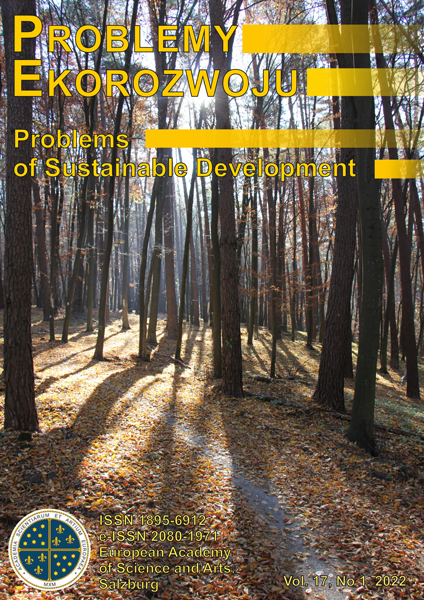Wzrost kapitału ludzkiego jako strategiczny priorytet zrównoważonego rozwoju regionów
Olena Krasnonosova*, Daria Mykhailenko**, Ihor Yaroshenko***
Macroeconomic Analysis and Forecasting Sector of the Macroeconomic Policy and Regional Development Department, Research Center for Industrial Development Problems of the National Academy of Sciences of Ukraine, Kharkiv, 1а Inzhenernii lane, 61166, Ukraine
*E-mail: krasnonosova@gmail.com, ORCID: 0000-0002-0863-3705
**E-mail: mikhailenko.dg@gmail.com, ORCID: 0000-0002-8420-6510
***E-mail: iyaroshenko@i.ua, ORCID: 0000-0001-7107-5550
Abstract
The main wealth of the country, its main strategic resource that can ensure political, economic, environmental, and spiritual growth, is human capital. Its intellectual, entrepreneurial, and productive potential, the ability to create and accumulate knowledge, implement it in the production of goods and services, develop unique technologies, invent new types of energy, materials, information, etc., is the engine of scientific and technological progress and innovative restructuring of the economy. Investment in human capital, in intelligence, in the health of the nation, in education and science, and in creating conditions for the normal functioning of everyone is a prerequisite not only for improving the quality of life of the people, but also for achieving the Millennium Goals and Sustainable Development Goals, advancing the country’s development, and its social and political stability.
The research is aimed at developing theoretical, methodological, and practical provisions for the formation of strategic priorities for sustainable development of territories based on the reproduction of human capital. The theoretical basis was the available scientific works, certain provisions of normative legal acts, international framework documents, in particular from United Nations: Agenda 21 and the report Our Common Future, as well as local studies.
The generalization of various scientific points of view regarding the category of human capital allowed us to establish that it is an integral part of its carrier, and therefore, it is proposed to understand as such a set of personal qualities of a person formed, developed, accumulated and preserved as a result of investments in productive abilities, personal qualities and motivational behavior of an individual, as well as the ability to develop and accumulate the necessary qualities that are in his property, which he uses in economic activities and which provides him with a corresponding income.
The article substantiates the value of the category human capital for sustainable development. The territorial features of the reproduction of human capital are determined, based on which it is proposed to consider the region as space. It is proved that the reproduction of human capital occurs in the relationship and interdependence with the general periods of the life cycle of the generation, which served to distinguish the four phases of the reproduction of human capital. The architectonics of determining the strategic priorities of sustainable development of territories based on the reproduction of human capital, which is aimed at solving theoretical, methodological, and applied problems, is proposed.
Key words: ecology, economy, society, sustainable development, human capital, reproduction, strategic priorities
Streszczenie
Głównym bogactwem kraju, jego głównym zasobem strategicznym, który może zapewnić rozwój polityczny, gospodarczy, środowiskowy i duchowy, jest kapitał ludzki. Jego potencjał intelektualny, przedsiębiorczy i produkcyjny, zdolność do tworzenia i gromadzenia wiedzy, wdrażania jej w produkcji towarów i usług, rozwijania unikalnych technologii, wynajdywania nowych rodzajów energii, materiałów, informacji itp. jest motorem postępu naukowo-technicznego i innowacyjności restrukturyzacji gospodarki. Inwestowanie w kapitał ludzki, w inteligencję, w zdrowie narodu, w edukację i naukę oraz w tworzenie warunków do normalnego funkcjonowania wszystkich jest warunkiem nie tylko poprawy jakości życia ludzi, ale także osiągnięcia Celów Milenijnych i Celów zrównoważonego rozwoju, w celu rozwoju kraju oraz wzrostu jego stabilności społecznej i politycznej.
Badania mają na celu wypracowanie teoretycznych, metodologicznych i praktycznych zapisów dla kształtowania strategicznych priorytetów zrównoważonego rozwoju terytoriów w oparciu o wzrost kapitału ludzkiego. Podstawą teoretyczną były dostępne opracowania naukowe, niektóre zapisy normatywnych aktów prawnych, międzynarodowe dokumenty ramowe, w szczególności ONZ: Agenda 21 i raport Nasza Wspólna Przyszłość, a także opracowania lokalne.
Uogólnienie różnych naukowych punktów widzenia w odniesieniu do kategorii kapitału ludzkiego pozwoliło ustalić, że jest on integralną częścią jego nosiciela, a zatem proponuje się rozumieć jako taki zespół cech osobowych ukształtowanej osoby, rozwijane, gromadzone i utrwalane w wyniku inwestycji w zdolności produkcyjne, cechy osobiste i zachowania motywacyjne jednostki, a także zdolność do rozwijania i gromadzenia niezbędnych cech znajdujących się w jej własności, którą wykorzystuje w działalności gospodarczej oraz co zapewnia mu odpowiedni dochód.
Artykuł uzasadnia wartość kategorii kapitału ludzkiego dla zrównoważonego rozwoju. Określane są terytorialne cechy reprodukcji kapitału ludzkiego, na podstawie których proponuje się traktować region jako przestrzeń. Udowodniono, że reprodukcja kapitału ludzkiego zachodzi w relacji i współzależności z ogólnymi okresami cyklu życia pokolenia, co posłużyło do wyodrębnienia czterech faz reprodukcji kapitału ludzkiego. Zaproponowano architektonikę wyznaczania strategicznych priorytetów zrównoważonego rozwoju terytoriów w oparciu o reprodukcję kapitału ludzkiego, która ma na celu rozwiązywanie problemów teoretycznych, metodologicznych i aplikacyjnych.
Słowa kluczowe: ekologia, ekonomia, społeczeństwo, zrównoważony rozwój, kapitał ludzki, reprodukcja, cele priorytetowe
Problemy Ekorozwoju 17(1)2022: 293-300
DOI: 10.35784/pe.2022.1.27
